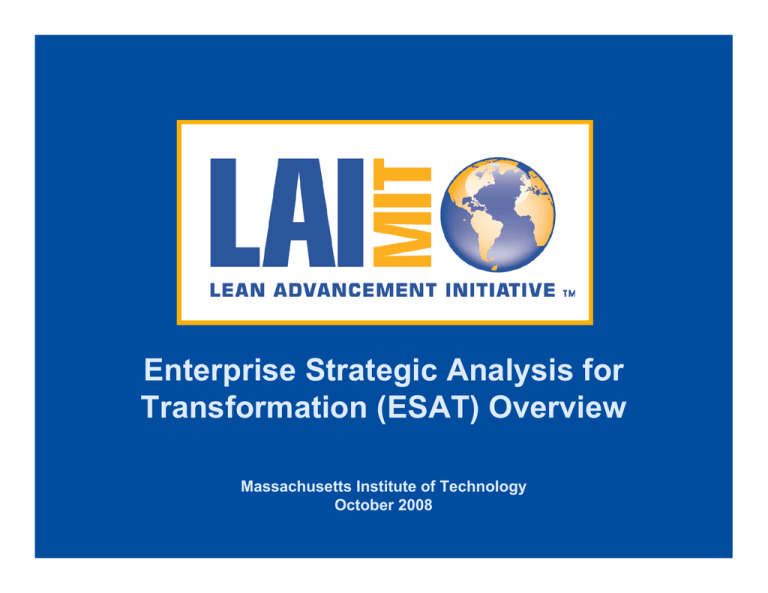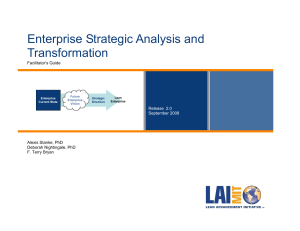Enterprise Strategic Analysis for Transformation (ESAT) Overview Massachusetts Institute of Technology October 2008
advertisement

Enterprise Strategic Analysis for Transformation (ESAT) Overview Massachusetts Institute of Technology October 2008 Why ESAT? The ESAT methodology is an integrated, analytical framework for diagnosing and improving overall enterprise performance • Emphasis of ESAT: • • • • • Qualitative and quantitative data points the way for creating: • • • • Understanding the enterprise value streams Value flow between key stakeholders and the enterprise, and Interactions both within and across the enterprise Allows the identification of enterprise wastes and opportunities A future state vision An actionable transformation plan and Governance structure to… Drive enterprise transformation http://lean.mit.edu © 2008 Massachusetts Institute of Technology October 2008- 2 Enterprise Strategic Analysis for Transformation • What distinguishes ESAT from other approaches to transformation? • A focus on the total enterprise • • Emphasis on enterprise-wide processes, rather than individual functions, programs or tasks Emphasis on value flows between the enterprise and its stakeholders • ESAT built upon well-tested, well-understood methods http://lean.mit.edu © 2008 Massachusetts Institute of Technology October 2008- 3 Enterprise Strategic Analysis and Transformation (ESAT) Strategic Objectives ESAT Enterprise Analysis Enterprise Identification Future State Vision Actionable Transformation Plan http://lean.mit.edu © 2008 Massachusetts Institute of Technology Presenter MM/ DD/YY- 4 1 2 • Enterprise Commitment • ESAT Team • Current Enterprise Goals Enterprise Strategic Analysis for Transformation • Team Charter • Enterprise Description: Boundaries, Stakeholders, Processes Collect Data Define the Enterprise 4 3 • Prioritized Stakeholder Values • LESAT Scores • Enterprise Resource Allocation • Processes Data • Current Metric Values 5 Leadership Processes • Stakeholder Value Analysis • Current State Process Map • Process Interactions Material Value Stream - ÒShop FloorÓ Product(s) & Service(s) Life Cycle Processes High Information Value Stream - ÒOffice FloorÓ Product / Service Quality Current Performance Enabling Processes Cost of Ownership Cycle Time Relationship with Corp. Low Relative Importance to Stakeholder Construct Current State Perspectives Identify Enterprise Opportunities High 6 Project A People Project B Processes Information Flow Project K Project E Project J Project D Customers Suppliers 9-block Initial Planning Template Project Name Project C Project H Project F Project G Project I Create Transformation Plans http://lean.mit.edu • Strategic Transformation Plan • Governance Model • Revised System of Metrics • Communication Plan JDI X Kaizen X Project Difficulty Event Description: Describe the task in sufficient detail. (one or two sentences) Reason for Event: Describe the problem the team is addressing and answers the Òwhy nowÓ question. • 3 - 5-yr Goal • Transformation Focus Areas • Waypoint Goals Describe Future State Vision 8 7 Impact Leadership • Alignment of Goals, Values, Processes, Metrics • List of Wastes • List of Opportunities Estimated Event Date(s): XXX Recommended Process Owner: XXX Recommended Team Leaders & Members: XXX Estimated Implementation Costs: None Estimated Savings: XXX Create Actionable Project Descriptions • Integrated Project Portfolios Transformation • Detailed Plan Descriptions • Recommended Metrics Create Deployment • Resources Plans Required by Project • Project Benefits © 2008 Massachusetts Institute of Technology Presenter MM/ DD/YY- 5 Pre-Planning Enterprise Strategic Analysis for Transformation Workshop 1 1 Collect Data 2 • Enterprise Commitment • ESAT Team • Current Enterprise Goals • Team Charter • Enterprise Description: Boundaries, Stakeholders, Processes Collect Data Define the Enterprise Workshop 2 4 3 • Prioritized Stakeholder Values • LESAT Scores • Enterprise Resource Allocation • Processes Data • Current Metric Values 5 Leadership Processes • Stakeholder Value Analysis • Current State Process Map • Process Interactions Material Value Stream - ÒShop FloorÓ Product(s) & Service(s) Life Cycle Processes High Information Value Stream - ÒOffice FloorÓ Product / Service Quality Current Performance Enabling Processes Cost of Ownership Cycle Time Relationship with Corp. Low Relative Importance to Stakeholder Construct Current State Perspectives Identify Enterprise Opportunities High 6 Project A People Project B Processes Information Flow Project E Project J Project D Customers Suppliers Project H Project F Project G Project I Create Transformation Plans • Strategic Transformation Plan • Governance Model • Revised System of Metrics • Communication Plan Describe Future State Vision 8 9-block Initial Planning Template Project Name Project C Project K • 3 - 5-yr Goal • Transformation Focus Areas • Waypoint Goals Workshop 3 7 JDI X Kaizen Impact Leadership • Alignment of Goals, Values, Processes, Metrics • List of Wastes • List of Opportunities X Project Difficulty Event Description: Describe the task in sufficient detail. (one or two sentences) Reason for Event: Describe the problem the team is addressing and answers the Òwhy nowÓ question. Estimated Event Date(s): XXX Recommended Process Owner: XXX Recommended Team Leaders & Members: XXX Estimated Implementation Costs: None Estimated Savings: XXX Create Actionable Project Descriptions Project Portfolios • Detailed Descriptions • Recommended Metrics • Resources Required by Project • Project Benefits • Integrated Transformation Plan Create Deployment Plans Goals and Expected Outcomes • • Create a vision of a lean enterprise three to five years in the future which optimizes enterprise value creation & delivery Provide enterprise executives with a balanced decision aid to: • • • • Identify barriers to the creation/delivery of value to each stakeholder Specify a vision of their future lean enterprise Determine significant gaps between current and future states Prioritize opportunities for eliminating waste and increasing value delivery for the maximum benefit of the total enterprise http://lean.mit.edu © 2008 Massachusetts Institute of Technology Presenter MM/ DD/YY- 7 Benefits of ESAT • Focuses at total enterprise level • Provides a cohesive method for diagnosing an enterprise • • • • • in order to expose sources of waste and to identify barriers to value delivery Gives consideration to the needs/values of all stakeholders Focuses on enterprise-wide processes Identifies process interfaces, disconnects and delays Establishes an enterprise vision for the future Identifies improvement opportunities that will benefit the entire enterprise http://lean.mit.edu © 2008 Massachusetts Institute of Technology Presenter MM/ DD/YY- 8 ESAT Generic Event Timeline Event Duration Step 0 Prep Workshop #1 Data Gathering Workshop #2 Project Refinement Workshop #3 1 day About 1 week, organization specific 2 days 3-4 weeks 1 week At least one week 3-5 days Approximate Total Duration 2 to 2 ½ months Note: Times shown are average times and may be adjusted for each enterprise context http://lean.mit.edu © 2008 Massachusetts Institute of Technology Presenter MM/ DD/YY- 9 Typical Resources Required • From organization doing ESAT event: • • • Enterprise leader as champion or sponsor Team lead & members are enterprise leader’s direct reports Enterprise process owners on an ad hoc basis as needed to provide information • Provided by LAI for assistance with event: • • Leader, with background in lean and ESAT method Additional facilitators to assist with the methodology • Time to complete the ESAT methodology - minimum of 2 to 2 ½ months of execution time http://lean.mit.edu © 2008 Massachusetts Institute of Technology Presenter MM/ DD/YY- 10 Summary The ESAT methodology provides: • Enterprise Perspective • Enables a clear definition of the enterprise as a whole • Fosters enterprise thinking and system-wide improvement • Stakeholder Centricity • • Process focuses on maximizing value delivery to all key enterprise stakeholders Emphasizes enterprise effectiveness over efficiency • Data Driven • Qualitative data through stakeholder interviews • Quantitative data from performance against key processes and strategic goals http://lean.mit.edu © 2008 Massachusetts Institute of Technology Presenter MM/ DD/YY- 11




